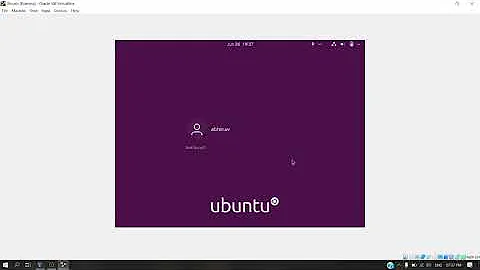Thunderbolt display not recognised with Ubuntu 16.04
I ran the command sudo xrandr -q and got the output:
Screen 0: minimum 8 x 8, current 1920 x 1080, maximum 32767 x 32767
HDMI-0 disconnected (normal left inverted right x axis y axis)
DP-0 connected primary 1920x1080+0+0 (normal left inverted right x axis y axis) 344mm x 194mm
1920x1080 60.02*+ 47.99
DP-1 disconnected (normal left inverted right x axis y axis)
DP-2 disconnected (normal left inverted right x axis y axis)
Then the command xrandr --listproviders
Providers: number : 2
Provider 0: id: 0x1e2 cap: 0x1, Source Output crtcs: 4 outputs: 4 associated providers: 0 name:NVIDIA-0
Provider 1: id: 0x46 cap: 0x2, Sink Output crtcs: 3 outputs: 4 associated providers: 0 name:modesetting
Then the command xrandr --setprovideroutputsource 1 0 and then xrandr --current
Screen 0: minimum 8 x 8, current 1920 x 1080, maximum 32767 x 32767
HDMI-0 disconnected (normal left inverted right x axis y axis)
DP-0 connected primary 1920x1080+0+0 (normal left inverted right x axis y axis) 344mm x 194mm
1920x1080 60.02*+ 47.99
DP-1 disconnected (normal left inverted right x axis y axis)
DP-2 disconnected (normal left inverted right x axis y axis)
DP-1-1 connected
2560x1440 59.95 +
1280x720 59.86
HDMI-1-1 disconnected
DP-1-2 disconnected
HDMI-1-2 disconnected
Notice DP-1-1 is now showing as connected. At this point I was able to open the display settings and see the Thunderbolt display. There I could enable it and configure. It appears to be working correctly now. I determined these steps from a post here
I then added the following command in the 'Startup Applications' dialog so that the settings persist after loging in and out.
/bin/bash -c "sleep 10&&xrandr --setprovideroutputsource 1 0 && xrandr --output DP-1-1 --auto --primary --left-of DP-0"
Related videos on Youtube
LaserJesus
Currently working in the big data space (> 1TB text) mostly with C# to provide real-time analytics over vast data. I utilise a lot of open source for storage, retrieval and filtering written in multiple languages, E.g.: Elastic Search, Solr, MongoDB, Rabbit MQ and MySql
Updated on September 18, 2022Comments
-
 LaserJesus almost 2 years
LaserJesus almost 2 yearsI'm setting up Ubuntu on a new Alienware R3 15. I have it dual booting with Windows 10. I also have a Thunderbolt display (Thunderbolt 2). I recently bought an adaptor so that that I can plug the Thunderbolt display into the Thunderbolt 3 port on the Laptop.
When I log into Windows the display is automatically recognised and works as expected. On Ubuntu the splash / load screen flashes for a second or two on the Thunderbolt display, then disappears. Then I just have the laptop screen working by the time the login screen loads. Once logged in, the displays dialog does not recognise the Thunderbolt monitor, only the laptop's screen. I've tried rebooting the machine as I understand hot plugging could be an issue. I had the same outcome after a reboot.
Any tricks to getting this to work? I'm using 16.04.2 LTS 64 bit with Gnome (3.18.5), I have a GeForce GTX 1070/PCIe/SSE2 card and the proprietary Nvidia 375.39 driver installed and selected. Again, no problems in Windows on the same machine.
Below is the output from running
lspci. From the directory here I believeIntel Corporation Device 15d9maps toJHL6340 Thunderbolt 3 NHI (C step) [Alpine Ridge 2C 2016]lspci -vt -[0000:00]-+-00.0 Intel Corporation Device 5910 +-01.0-[01]----00.0 NVIDIA Corporation Device 1be1 +-01.2-[02-3a]----00.0-[03-3a]--+-00.0-[04]----00.0 Intel Corporation Device 15d9 | +-01.0-[05-39]-- | \-02.0-[3a]-- +-02.0 Intel Corporation Device 591b +-04.0 Intel Corporation Skylake Processor Thermal Subsystem +-14.0 Intel Corporation Sunrise Point-H USB 3.0 xHCI Controller +-14.2 Intel Corporation Sunrise Point-H Thermal subsystem +-16.0 Intel Corporation Sunrise Point-H CSME HECI #1 +-17.0 Intel Corporation Sunrise Point-H SATA controller [AHCI mode] +-1c.0-[3b]-- +-1c.4-[3c]----00.0 Qualcomm Atheros Device e0b1 +-1c.5-[3d]----00.0 Qualcomm Atheros QCA6174 802.11ac Wireless Network Adapter +-1d.0-[3e]----00.0 Toshiba America Info Systems Device 0115 +-1f.0 Intel Corporation Sunrise Point-H LPC Controller +-1f.2 Intel Corporation Sunrise Point-H PMC +-1f.3 Intel Corporation Device a171 \-1f.4 Intel Corporation Sunrise Point-H SMBus -
 LonnieBest about 6 yearsNice instructions. You should submit this as a bug also; perhaps, then, someone will automate these steps so everyone who tries out their MAC display on Ubuntu won't have to go through the trouble you did.
LonnieBest about 6 yearsNice instructions. You should submit this as a bug also; perhaps, then, someone will automate these steps so everyone who tries out their MAC display on Ubuntu won't have to go through the trouble you did. -
 LonnieBest about 6 yearsWhat adapter did you get? Please post here.
LonnieBest about 6 yearsWhat adapter did you get? Please post here. -
Scorpius almost 5 years@LonnieBest did anyone report this as a bug in the end? Here I am a year and some change later and this is still not plug and play on Ubuntu. I still have to try these steps manually, but I have to keep switching from an HDMI source and back to test. I would personally love to know to which agency to report the issue—is this an Ubuntu issue, Linux issue, USB-C/Thunderbolt/Intel issue?
-
 LonnieBest almost 5 years@Scorpius : You might explain this in a bug report here. It is tricky, because Ubuntu actually has no problem running the Monitor, when you install Ubuntu onto a MAC mini. Yet, on non-mac-hardware, the adapters I've tried don't even know how to turn the Monitor on (it seem). This wonderful monitor doesn't even have a power button!
LonnieBest almost 5 years@Scorpius : You might explain this in a bug report here. It is tricky, because Ubuntu actually has no problem running the Monitor, when you install Ubuntu onto a MAC mini. Yet, on non-mac-hardware, the adapters I've tried don't even know how to turn the Monitor on (it seem). This wonderful monitor doesn't even have a power button! -
 JVMATL over 4 years@LonnieBest - are you saying you installed Ubuntu on a Mac Mini and the thunderbolt display was detected and used automatically? Which version Mac Mini hardware? Which version Ubuntu? I'm trying (and failing) to get the TB display to work from my late 2013 MBP... (the display's USB components are working, but no picture. :(
JVMATL over 4 years@LonnieBest - are you saying you installed Ubuntu on a Mac Mini and the thunderbolt display was detected and used automatically? Which version Mac Mini hardware? Which version Ubuntu? I'm trying (and failing) to get the TB display to work from my late 2013 MBP... (the display's USB components are working, but no picture. :( -
 LonnieBest over 4 years@JVMATL : Yes, that's what I'm saying. The Mac Mini I did it on seems to be about the same year as yours, but I can't verify it right now where I'm at. I've accomplished this on Ubuntu 16.04 and 18.04; the monitor turns on and just works and looks GREAT! I also installed a Samsung SSD into it and it runs fast. Be careful going inside of the Mac Mini, I bent the fan housing and had to order a new one, also, you'll need a mac screw driver kit to accomplish any upgrades.
LonnieBest over 4 years@JVMATL : Yes, that's what I'm saying. The Mac Mini I did it on seems to be about the same year as yours, but I can't verify it right now where I'm at. I've accomplished this on Ubuntu 16.04 and 18.04; the monitor turns on and just works and looks GREAT! I also installed a Samsung SSD into it and it runs fast. Be careful going inside of the Mac Mini, I bent the fan housing and had to order a new one, also, you'll need a mac screw driver kit to accomplish any upgrades.




